Natural Capital
Our manufacturing process is reliant on various natural resources and also has its own impact on the environment. We are continuously balancing sustainable practices and resource efficiency to preserve precious resources and minimise our ecological footprint.
SDGs impacted
#0
Worldwide Rank of the IJmuiden steelworks of Tata Steel Nederland in the 2022 CO2 intensity benchmark
0 tCO2
Greenhouse gas emission
intensity per tonne of
crude steel
Net Zero
by 2045

Material issues addressed
- Greenhouse Gas Emissions and Climate Change Management
- Air Pollution/Air Quality Management
- Water Consumption and Effluent Discharge/Water Resource Management
- Energy Efficiency/Energy Management
- Circular Economy/Recycling of By-products
- Biodiversity
- Risk Management
- Supply Chain Sustainability
Strategic linkages
SO4
SE
Preserving resources, sustaining the nature
Steel, with a resource-intensive manufacturing process, generates emissions and effluents, impacting the nature. We are conscious of our ecological footprint and strive to use efficient production routes, minimise waste generation and mitigate the negative impact on the environment by relentlessly optimising the use of the natural resources, reducing emissions and encouraging circular economy.
To manage our natural capital, we are investing in various environmental projects such as air emissions control equipment installation, use of scrap in steel making, freshwater consumption minimisation, and explore opportunities in circular economy.
Our operational excellence mantra is ‘Prevent, Reduce, Recover, Reuse and Recycle’. We continue our pursuit of establishing best-in-class facilities and ensure ecosystem healthiness.
Air emissions
Integrated steel manufacturing operations generate emissions into air, primarily in the form of dust and gaseous emissions such as Sulphur dioxide and Nitrous oxides.
Specific dust load is the key environment performance indicator for Tata Steel and at all our operating sites and we have the necessary infrastructure, best of the monitoring technologies and capabilities to constantly track the specific dust load on a real-time basis.
We have conducted ‘Source Apportionment’ studies at our Jamshedpur Works and in the radius of 20 kilometers to identify key sources and their contribution to the overall ambient air quality in the region with an aim to develop air quality management plans to improve the ambient air quality.
We are in the process of taking every possible step to reduce the air impact of our operations through “Responsible Production and Consumption”. At the process level, lot of initiatives have been implemented across all sites, primarily with a focus on upgradation of the existing air pollution control equipment and redesigning the control equipment at a level that is lower by 50% to 80% than the prevailing prescribed norms. This has resulted in significant reduction of stack dust load at all sites in India.
0%
Estimated reduction in specific stack dust emissions since FY2004-05 at Tata Steel Limited.
Strive towards sustainability leadership
Align with its strategic objective of ‘Leadership in sustainability’, Tata Steel has adopted policies intended to help it become the international benchmark in stack dust emission by 2030 and is currently developing strategies and conducting feasibility studies, as below:
- Installation of Air Pollution Control Equipment (APCE) for benchmark performance
- Improvement or de-bottlenecking of existing APCE
- Implementation of best available technology for APCE for new facilities
In our IJmuiden operations, in April 2022, we commissioned several new slag pits with a mobile covering to reduce dust. Currently, the entire converter slag flow is cooled under a cover and a thick mist curtain ensures that as much dust as possible remains in the pit and that any dust that is released precipitates immediately. This process is designed to reduce dust emissions by approximately 80%.
Tata Steel Nederland’s nitrogen oxide emissions have already been reduced by approximately 20% over the past two decades. Tata Steel is putting up a new DeNOx installation at the Pelletising Plant, which is part of Tata Steel Nederland’s multi-year Roadmap+ investments of c. €300M. The DeNOx installation is expected to reduce Tata Steel’s total nitrogen oxide emissions at IJmuiden by c. 30%, compared to 2019, upon commissioning in 2025. As part of the Pellet Plant, Tata Steel has introduced a new technology that has not yet been applied on this scale elsewhere in the steel industry.
Water management
Steel plants require substantial water for cooling, dust suppression, cleaning, temperature control (heat treatment), transport of waste materials (ash, sludge and mill scale), among others. Water is a key material issue for Tata Steel in India and we are committed to conserving water. Our European operations are based out of coastal locations and have access to adequate water supply.
Tata Steel is looking to minimise fresh water withdrawal from rivers while maximising the recycling of treated waste effluents within the plants. We are also reusing treated municipal wastewater and have water harvesting infrastructure across locations, helping reduce dependence on rivers, and enhance water security.
Over the last two decades, various upgradation and improvement projects in the water system were initiated at all our Indian sites to minimise water consumption. Best of the available technologies were adopted to reduce, recover, recycle and reuse the treated wastewater. We reuse the treated effluents for low-end applications like coke quenching, blast furnace slag granulation, steel slag quenching, sinter/pellet mixing, gas cleaning plant, horticulture, and dust suppression among others.
Major initiatives taken by Tata Steel (in India) in FY2022-23 to minimise its specific freshwater consumption and reduction of effluent discharge include:
- Enhancing water recovery through augmentation of Central Effluent Treatment Plant from 4 million gallons per day (MGD) to 9 MGD at Jamshedpur
- Increasing recovery of treated water from Sewage Treatment Plants at the township of Jamshedpur
- Increasing storm water recovery and reduction in freshwater consumption at production units in Kalinganagar
- Maximising use of treated effluent at Blast Furnace 2, Direct Reduced Iron Plant, Sinter Plants and auxiliary consumption at Meramandali Tata Steel aspires to set global
Tata Steel aspires to set global steel industry benchmark in specific freshwater consumption to less than 1.50 m3 /tonne of crude steel by 2030 for its Indian operations. The roadmap is being prepared in collaboration with expert agencies, to be future ready to deal with water stress. Initiatives to achieve the goal include enhancing recovery recycling reuse of wastewater, eliminating losses in the processes, adopting dry process like gas cleaning plant in the blast furnaces and steel melting shops, process-level benchmarking and improvements and enhancing rainwater harvesting.
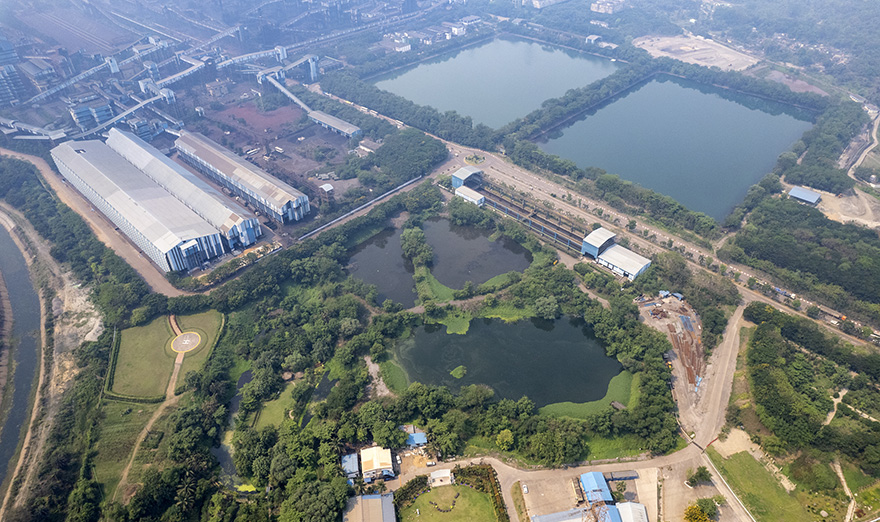
Conserving precious natural resources
0 %
Reduction in specific fresh water consumption since FY2004-05 at Tata Steel Limited
Product sustainability
We strive to use the Life Cycle Assessment (LCA) tool effectively to evaluate and communicate our products’ environmental performance across its lifecycle. Our LCA studies are done in accordance with WorldSteel LCA methodology, guided by ISO14040 and ISO14044 standards. Aligning with the goal to cover all steelmaking and downstream sites under LCA, this year, we have completed the LCA study for downstream facilities at Khopoli and Sahibabad and Cold Rolling Complex at Tarapur, covering 8 different product categories. In FY2022-23, Tata Steel published its first Environment Product Declaration (EPD) for Steel Rebars, for facilities in Jamshedpur works as well as other Steel Processing Centers. This was followed by EPD for Steel structural hollow section, under the brand Tata Structura, manufactured at Tata Steel Tubes Division and other different production units. EPD was published for Steel Hot Rolled Coil, covering all manufacturing locations across Jamshedpur, Kalinganagar and Meramandali. Furthermore, Tata EzyFit, which is a brand of innovative tubes for windows and doorframe section, received GreenPro certification. We have also carried out a LCA study for one of our Fibre Reinforced Polymer products to understand its life cycle environmental impact.
GreenPro
Certification received for the Tata Ezyfit brand
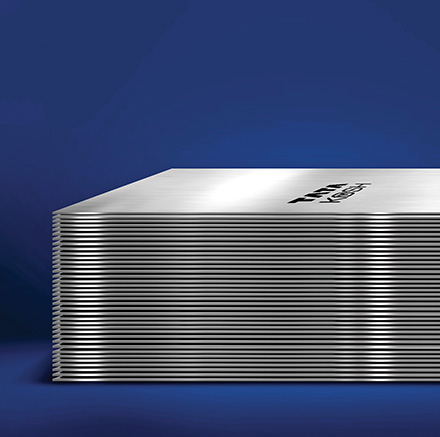
Ensuring product sustainability
In the coming years, we aim to receive eco-labels (GreenPro) and disclose environmental performance transparently, for our key products manufactured across various sites to support our customers with product related sustainability information.
At our European operations, we developed the Product Assessment Carbon Indicator tool. The tool streamlines the process of undertaking life cycle studies of products and enables an understanding of greenhouse gas emission hot spots and trade-offs in the steel product value chain, which can be used to inform new product developments and optimise existing manufacturing routes. The tool has been used to support collaborative projects with customers and to support sharing and learning opportunities for emissions reduction over the product’s life cycle from manufacturing through use and finally end-of-life (e.g. working with an automotive OEM to examine all aspects of material selection including material type, steel grade, gauge and aspects of formability and part design, the use of the tool in understanding the trade-off between benefits in use from improving motor efficiency versus embodied emissions associated with different grades of electrical steels, etc.). The tool has been recognised by the worldsteel Association, with a Steelie award for Excellence in Life Cycle Assessment.
Solid waste management
In the endeavour to develop a sustainable ecosystem for by-product management, we have been striving to create value from wastes by adopting 3R (Reduce, Reuse & Recycle) principles of circular economy. Tata Steel handles c. 15 MnTPA of by-products across 25+ product categories comprising more than 250+ stock keeping units in India. These value-added by-products serve as key raw materials to various industries like cement, chemical, construction etc. In FY2022-23, Tata Steel achieved 100% solid waste utilisation at Jamshedpur, Kalinganagar and Meramandali units.
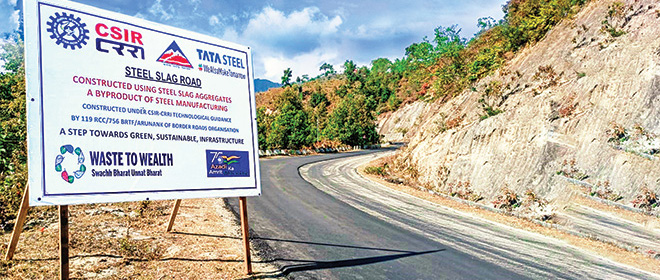
Road made using steel slag aggregates
Bringing innovation in sustainability
Over the years, Tata Steel has taken several initiatives to harness by-products. Tata Aggreto and Tata Nirman, India’s 1st branded steel slag products, are being extensively used in construction applications as sustainable alternatives to natural aggregates. In a first-of-its-kind initiative, steel slag was used to construct the road connecting Sino-India border in Arunachal Pradesh by the Border Roads Organisation, under Project Arunank. The technology of accelerated weathering (steam aging facility) of steel slag, developed in-house, has been successfully deployed at the Kalinganagar plant.
Tata Steel focuses on establishing a resource circulation system at the organisational level. Some of the key circularity initiatives include Ladle Furnace slag briquetting at Jamshedpur and consumption in steel shops as replacement of lime and conversion of steel sludge to pellets and reuse in iron making at Meramandali. Tata Steel has also developed a robust pipeline of eco-friendly light construction products such as paver blocks, autoclaved aerated concrete blocks, and interlocking blocks, manufactured using iron and steel slags.
In another milestone, Tata Steel has set up an External Processing Agent based facility for production of Dhurvi Gold, a new crop nutrient product, based out of steel slag. The product is a sulphur-rich nutrient soil conditioner, favourably impacting soil characteristics, thereby resulting in good growth, quality and economic yield across crops.
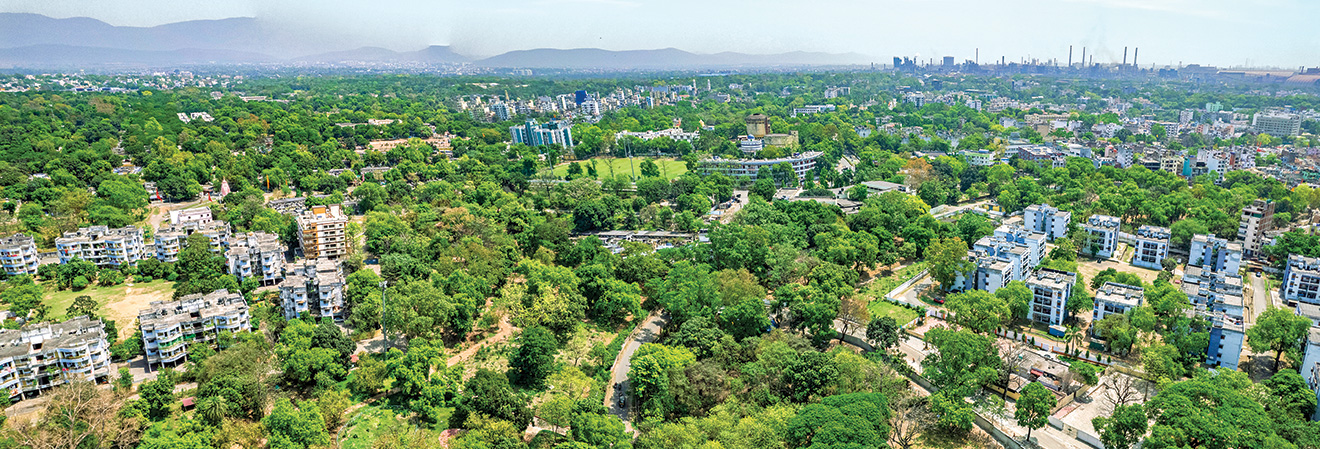
Kadma Biodiversity Park, Jamshedpur
Biodiversity management
Tata Steel has made significant efforts to persistently improve and enhance its performance in biodiversity conservation and significantly reduce its impact on the ecosystem. Our Indian operations are not located in any of the identified biodiversity hotspots or protected areas.
During FY2022-23, we developed the Biodiversity Management Plans (BMP) for Tarapur and Sahibabad sites and have developed BMPs for 17 locations across India till date. Tata Steel plans to cover 100% sites to assess the impact and dependence of direct operations on biodiversity by 2025. We have planted over 4 lakh saplings of native species across all locations. Tata Steel has also set up the Kadma Biodiversity Park, spread across 13.5 acres, where 5,650 trees and 4,650 shrubs have been planted. The park has a 2.3 kilometres walking trail, a yoga and meditation zone, bird watching areas, rainwater harvesting ponds, lily ponds, butterfly zones and fruit and bamboo orchards. The park houses several clusters of native species of trees planted as groves. It also has bird and squirrel nests, deep forest areas, grass lands and an information centre for flora and fauna.
At our UK operations, we are guardian to large areas of natural habitat, including several Sites of Special Scientific Interest (SSSI). In addition to meeting our responsibilities for protected sites, we also look for opportunities to encourage biodiversity on other landholdings and thereby contribute to protecting the natural heritage of UK’s landscape. Former blast furnace cooling lagoons at our Shotton site are now a haven for wildlife. From attracting 12 nesting pairs of common tern in 1970, with the creation of a small raft on the lagoon, the area has since become home to one of the UK’s largest colonies of this vulnerable bird species and has seen over 20,000 chicks fledge successfully. The site has been a nature reserve for 50 years and a designated SSSI since 1990.
0 lakh
Saplings of native species planted across locations in India
Circular economy
Steel is amenable to recycling and producing steel from ferrous scrap entails a lower carbon footprint as opposed to producing it through virgin route. Tata Steel’s first-of-its-kind scrap collection and processing unit at Rohtak was commissioned in 2020 and the plant clocked c. 280 KT of scrap dispatch in FY2022-23.
The Company's Steel Scrap Recycling Business aims to replicate the Rohtak model across India by setting up 8-10 fully mechanised scrap processing facilities, with a combined capacity of 5 MnTPA by 2030. Steel Recycling Business (SRB) has leveraged the power of digital technology to set up robust supply chains, as the collection and aggregation of scrap for the recycling plant entails reverse logistics. FerroHaat, a digital app, was launched to source steel scrap from the scrapyards.
0.75 MnTPA EAF based steel plant is being set up at Ludhiana, Punjab at an investment of ₹2,600 crore to make steel by recycling scrap
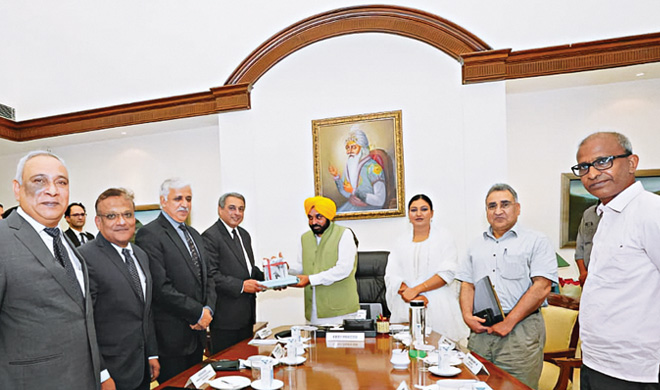
MoU with the Punjab Government for an Electric Arc Furnace (EAF) plant in Ludhiana
Tata Steel has also signed an MoU with the Punjab Government and has started work to set up a 0.75 MnTPA electric arc furnace based long products steel plant at Ludhiana. The proposed plant will use steel scrap instead of iron ore. The investment is part of Tata Steel’s commitment to investing in a circular economy and transitioning to low-carbon steelmaking through the steel recycling route. It is a step aligned to the Company’s goal of achieving Net Zero carbon emission by 2045.
There has also been a dedicated effort to increase scrap charging in our steel melting shops, which is one of the key enablers for reduction in carbon footprint. Continuous efforts have been directed towards augmenting the infrastructure for scrap management and processing, in order to increase the scrap charge for our India operations. At our steelmaking sites in the Netherlands and the UK, we already use high proportion of ferrous scrap in our ore-based steel production processes, consistently achieving approximately 17% recycled content in our steel.
Tata Steel in UK has also been instrumental in setting up the national infrastructure to create an end market for steel packaging at the end of its life. All local authorities now collect steel packaging at the kerbside, contributing to the UK’s high recycling rates for packaging steel and demonstrating that steel is a sustainable packaging material while providing valuable feedstock for our furnaces.